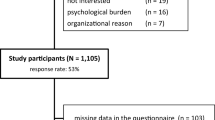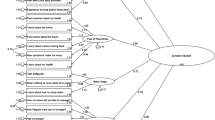Abstract
Purpose
Cross-sectional studies have established the prevalence and functional impairment of somatic symptoms in cancer patients. The purpose of this study was to determine the trajectory and adverse consequences of such symptoms over time.
Methods
Secondary analysis of longitudinal data from 405 cancer patients enrolled in a telecare management trial for pain and/or depression. Somatic symptom burden was measured with a 22-item scale at baseline, 1, 3, 6, and 12 months. Outcomes included the SF-12 Physical Component Summary (PCS) and Mental Component Summary (MCS) scores, the Sheehan Disability Scale (SDS) score, and self-reported total disability days. Mixed methods repeated measures analyses were conducted to determine whether antecedent change in somatic symptom burden predicted functional status and disability.
Results
Symptoms were highly prevalent at baseline, with 15 of the 22 symptoms endorsed by more than half of the patients. A rather constant cross-sectional prevalence over 12 months at the group level belied a quite different trajectory at the patient level where the median persistence, resolution, and incidence rates for 14 of the most common symptoms were 39 %, 37 %, and 24 %, respectively. A clinically significant (i.e., five points) reduction in somatic symptom burden predicted improvement in PCS, MCS, and SDS (all P < 0.001), as well as a lower likelihood of ≥14 disability days in the past 4 weeks (odds ratio, 0.84; 95 % CI, 0.74 to 0.95).
Conclusions
Somatic symptoms remain burdensome in cancer patients over 12 months and symptom improvement predicts significantly better functional status and less disability.


Similar content being viewed by others
References
Funch DP (1988) Predictors and consequences of symptom reporting behaviors in colorectal cancer patients. Med Care 26:1000–1008
Curtis EB, Krech R, Walsh TD (1991) Common symptoms in patients with advanced cancer. J Palliat Care 7:25–29
Grond S, Zech D, Diefenbach C, Bischoff A (1994) Prevalence and pattern of symptoms in patients with cancer pain: a prospective evaluation of 1635 cancer patients referred to a pain clinic. J Pain Symptom Manage 9:372–382
Portenoy RK, Thaler HT, Kornblith AB, Lepore JM, Friedlander-Klar H, Coyle N et al (1994) Symptom prevalence, characteristics and distress in a cancer population. Qual Life Res 3:183–189
Donnelly S, Walsh D, Rybicki L (1995) The symptoms of advanced cancer: identification of clinical and research priorities by assessment of prevalence and severity. J Palliat Care 11:27–32
Vainio A, Auvinen A (1996) Prevalence of symptoms among patients with advanced cancer: an international collaborative study. Symptom Prevalence Group. J Pain Symptom Manage 12:3–10
Chang VT, Hwang SS, Feuerman M, Kasimis BS (2000) Symptom and quality of life survey of medical oncology patients at a veterans affairs medical center: a role for symptom assessment. Cancer 88:1175–1183
Cleeland CS, Mendoza TR, Wang XS, Chou C, Harle MT, Morrissey M et al (2000) Assessing symptom distress in cancer patients: the M.D. Anderson Symptom Inventory. Cancer 89:1634–1646
Homsi J, Walsh D, Rivera N, Rybicki LA, Nelson KA, Legrand SB et al (2006) Symptom evaluation in palliative medicine: patient report vs systematic assessment. Support Care Cancer 14:444–453
Teunissen SC, Wesker W, Kruitwagen C, de Haes HC, Voest EE, de Graeff A (2007) Symptom prevalence in patients with incurable cancer: a systematic review. J Pain Symptom Manage 34:94–104
Yamagishi A, Morita T, Miyashita M, Kimura F (2009) Symptom prevalence and longitudinal follow-up in cancer outpatients receiving chemotherapy. J Pain Symptom Manage 37:823–830
Kim JE, Dodd MJ, Aouizerat BE, Jahan T, Miaskowski C (2009) A review of the prevalence and impact of multiple symptoms in oncology patients. J Pain Symptom Manage 37:715–736
Dodd MJ, Miaskowski C, Paul SM (2001) Symptom clusters and their effect on the functional status of patients with cancer. Oncol Nurs Forum 28:465–470
Fox SW, Lyon DE (2006) Symptom clusters and quality of life in survivors of lung cancer. Oncol Nurs Forum 33:931–936
Given BA, Given CW, Sikorskii A, Hadar N (2007) Symptom clusters and physical function for patients receiving chemotherapy. Semin Oncol Nurs 23:121–126
Ferreira KA, Kimura M, Teixeira MJ, Mendoza TR, da Nobrega JC, Graziani SR et al (2008) Impact of cancer-related symptom synergisms on health-related quality of life and performance status. J Pain Symptom Manage 35:604–616
Hadi S, Fan G, Hird AE, Kirou-Mauro A, Filipczak LA, Chow E (2008) Symptom clusters in patients with cancer with metastatic bone pain. J Palliat Med 11:591–600
Foley KM (1991) The relationship of pain and symptom management to patient requests for physician-assisted suicide. J Pain Symptom Manage 6:289–297
Kroenke K, Theobald D, Norton K, Sanders R, Schlundt S, McCalley S et al (2009) Indiana Cancer Pain and Depression (INCPAD) Trial: design of a telecare management intervention for cancer-related symptoms and baseline characteristics of enrolled participants. Gen Hosp Psychiatry 31:240–253
Kroenke K, Theobald D, Wu J, Norton K, Morrison G, Carpenter J et al (2010) Effect of telecare management on pain and depression in patients with cancer: a randomized trial. JAMA 304:163–171
Kroenke K, Spitzer RL (2002) The PHQ-9: a new depression and diagnostic severity measure. Psychiatr Ann 32:509–521
Kroenke K, Strine TW, Spitzer RL, Williams JB, Berry JT, Mokdad AH (2009) The PHQ-8 as a measure of current depression in the general population. J Affect Disord 114:163–173
Kroenke K, Spitzer RL, Williams JBW (2002) The PHQ-15: validity of a new measure for evaluating the severity of somatic symptoms. Psychosom Med 64:258–266
Portenoy RK, Kornblith AB, Lepore JM, Friedlander-Klar H, Kiyasu E, Sobel K et al (1994) The Memorial Symptom Assessment Scale: an instrument for the evaluation of symptom prevalence, characteristics and distress. Eur J Cancer 30A:1326–1336
Ware J Jr, Kosinski M, Keller SD (1996) A 12-Item Short-Form Health Survey: construction of scales and preliminary tests of reliability and validity. Med Care 34:220–233
Sheehan DV, Harnett-Sheehan K, Raj BA (1996) The measurement of disability. Int Clin Psychopharmacol 11(Suppl 3):89–95
Rost K, Nutting P, Smith J, Werner J, Duan N (2001) Improving depression outcomes in community primary care practice: a randomized trial of the quEST intervention. Quality Enhancement by Strategic Teaming. J Gen Intern Med 16:143–149
Kroenke K, Bair MJ, Damush TM, Wu J, Hoke S, Sutherland J et al (2009) Optimized antidepressant therapy and pain self-management in primary care patients with depression and musculoskeletal pain: a randomized controlled trial. JAMA 301:2099–2110
Unutzer J, Katon W, Callahan CM, Williams JW Jr, Hunkeler E, Harpole L et al (2002) Collaborative care management of late-life depression in the primary care setting: a randomized controlled trial. JAMA 288:2836–2845
Perkins AJ, Kroenke K, Unutzer J, Katon W, Williams JW, Hope C et al (2004) Common comorbidity scales were similar in their ability to predict health care costs and mortality. J Clin Epidemiol 57:1040–1048
Kroenke K, Zhong X, Theobald D, Wu J, Tu W, Carpenter JS (2010) Somatic symptoms in patients with cancer experiencing pain or depression: prevalence, disability, and health care use. Arch Intern Med 170:1686–1694
Kroenke K, Wu J, Bair MJ, Krebs EE, Damush TM, Tu W (2011) Reciprocal relationship between pain and depression: a 12-month longitudinal analysis in primary care. J Pain 12:964–973
Wang H-L, Kroenke K, Wu J, Tu W, Theobald D, Rawl SM (2011) Cancer-related pain and disability: a longitudinal study. J Pain Symptom Manage 42:813–821
Kroenke K (2003) Patients presenting with somatic complaints: epidemiology, psychiatric comorbidity and management. Int J Methods Psychiatr Res 12:34–43
Kjaer TK, Johansen C, Ibfelt E, Christensen J, Rottmann N, Hoybye MT et al (2011) Impact of symptom burden on health related quality of life of cancer survivors in a Danish cancer rehabilitation program: a longitudinal study. Acta Oncol 50:223–232
Harrington CB, Hansen JA, Moskowitz M, Todo BL, Feuerstein M (2010) It's not over when it's over: long-term symptoms in cancer survivors—a systematic review. Int J Psychiatry Med 40:163–181
Given C, Given B, Rahbar M, Jeon S, McCorkle R, Cimprich B et al (2004) Effect of a cognitive behavioral intervention on reducing symptom severity during chemotherapy. J Clin Oncol 22:507–516
Sherwood P, Given BA, Given CW, Champion VL, Doorenbos AZ, Azzouz F et al (2005) A cognitive behavioral intervention for symptom management in patients with advanced cancer. Oncol Nurs Forum 32:1190–1198
Sikorskii A, Given CW, Given B, Jeon S, Decker V, Decker D et al (2007) Symptom management for cancer patients: a trial comparing two multimodal interventions. J Pain Symptom Manage 34:253–264
Jackson JL, O'Malley PG, Kroenke K (2006) Antidepressants and cognitive-behavioral therapy for symptom syndromes. CNS Spectr 11:212–222
Conflict of interest
The authors have no conflicts of interest to declare with respect to the contents of this paper.
Author information
Authors and Affiliations
Corresponding author
Additional information
Funding: This study was supported by a grant from the National Cancer Institute to Dr. Kroenke (R01 CA-115369)
Rights and permissions
About this article
Cite this article
Kroenke, K., Johns, S.A., Theobald, D. et al. Somatic symptoms in cancer patients trajectory over 12 months and impact on functional status and disability. Support Care Cancer 21, 765–773 (2013). https://doi.org/10.1007/s00520-012-1578-5
Received:
Accepted:
Published:
Issue Date:
DOI: https://doi.org/10.1007/s00520-012-1578-5




